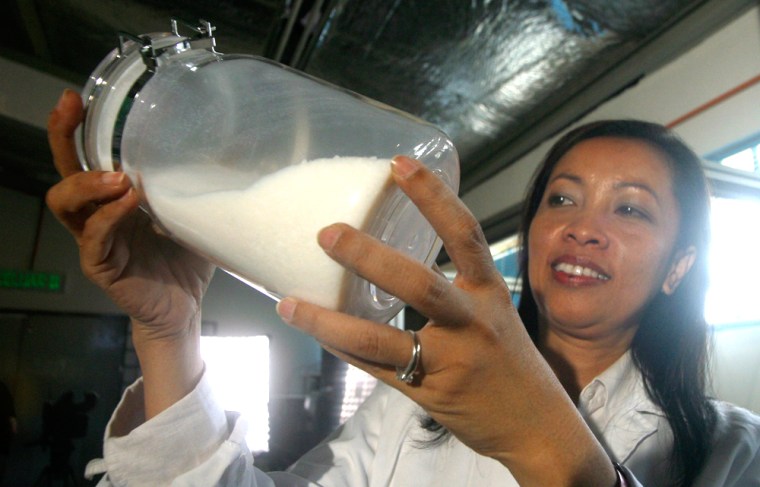A Malaysian scientist says she has discovered a cheap way to turn discarded rice husks into a high-tech material that could reduce electricity bills, protect buildings from bomb blasts and make airplanes and tennis rackets lighter.
Aerogel, the lightest solid known to man, was invented in 1931 by an American scientist, but its high cost has limited its use.
Halimaton Hamdan, a University of Cambridge-trained chemistry professor, says her process cuts the cost of producing aerogel by 80 percent, making it so affordable that it could become a commonplace material with widespread use.
Her process is experimental and several years away from commercial use. The Malaysian government is funding a $62.5 million project at Halimaton's university in the southern town of Skudai to try to demonstrate that it can be produced on a large scale. She says 3.5 ounces will cost $60 to make, compared to $300 for conventional methods.
The greatest potential lies in coating walls of homes with aerogel, Halimaton says, which could dramatically reduce the need for heating and air conditioning. Aerogel provides 37 times more effective insulation than traditional fiberglass, according to ICE Circle, a British nonprofit group that promotes new technologies to fight climate change.
"I hope one day this product will be used by a variety of industries and benefit mankind," Halimaton told The Associated Press in her one-story laboratory at Universiti Teknologi Malaysia.
Scientific colleagues say her work is promising.
She "seems to have found a miracle solution" to make aerogel cheaply, said Vincent Blech, a scientist at the National Museum of Emerging Science and Innovation in Tokyo.
Dieter Freude, a physics professor at the University of Leipzig in Germany who is familiar with Halimaton's work, called it "an exciting breakthrough."
Nicknamed "frozen smoke" because of its cloudy appearance, aerogel is made from silica, the basic ingredient in sand, and is 99 percent air by volume. The result is a nearly weightless and translucent material with a white powder that seems to float inside.
What makes aerogel so attractive is the combination of light weight with incredible strength and insulating properties.
Dunlop Sport, the sporting goods company, has developed squash and tennis rackets strengthened with aerogel.
Aerogel can withstand mechanical pressure 2,000 times its own weight, making it suitable for bombproof panels. It makes good soundproofing material. Aerogel also can absorb oil spills and pollutants in the air — NASA fitted a space probe in 1999 with a mitt packed with the substance to catch the dust from a comet's tail.
Halimaton's interest in aerogel was accidental. After returning to Malaysia from the University of Cambridge in 2000, she wanted to do research on silica but had trouble finding the raw material.
One night, she saw a television program about Malaysian farmers in a quandary over how to dispose of rice husks after harvest. Halimaton had found her source: Silica is 20 percent of the total weight of rice husk.
Later that year, she read an article on aerogel that mentioned the high cost of silica — and a scientific challenge was born.
She dubbed her product "Maerogel," short for Malaysian aerogel.
Even then, she had no thought of selling it.
But at a British invention convention last year, she was discovered by ICE Circle founder Renu Mehta, who encouraged Halimaton to try to develop the product commercially. "It should feature prominently in strategies to reduce greenhouse gas carbon emissions," Mehta said.
It took Halimaton seven years to perfect the system.
Despite several failures — at times, her staff even broke down in tears — Halimaton persisted.
"I knew it was going to work. It was only a matter of time before I found a way to do it," she said. "As a scientist you lose sleep over a problem. You keep thinking how it can work. And at the spur of the moment, the answer comes to you."
